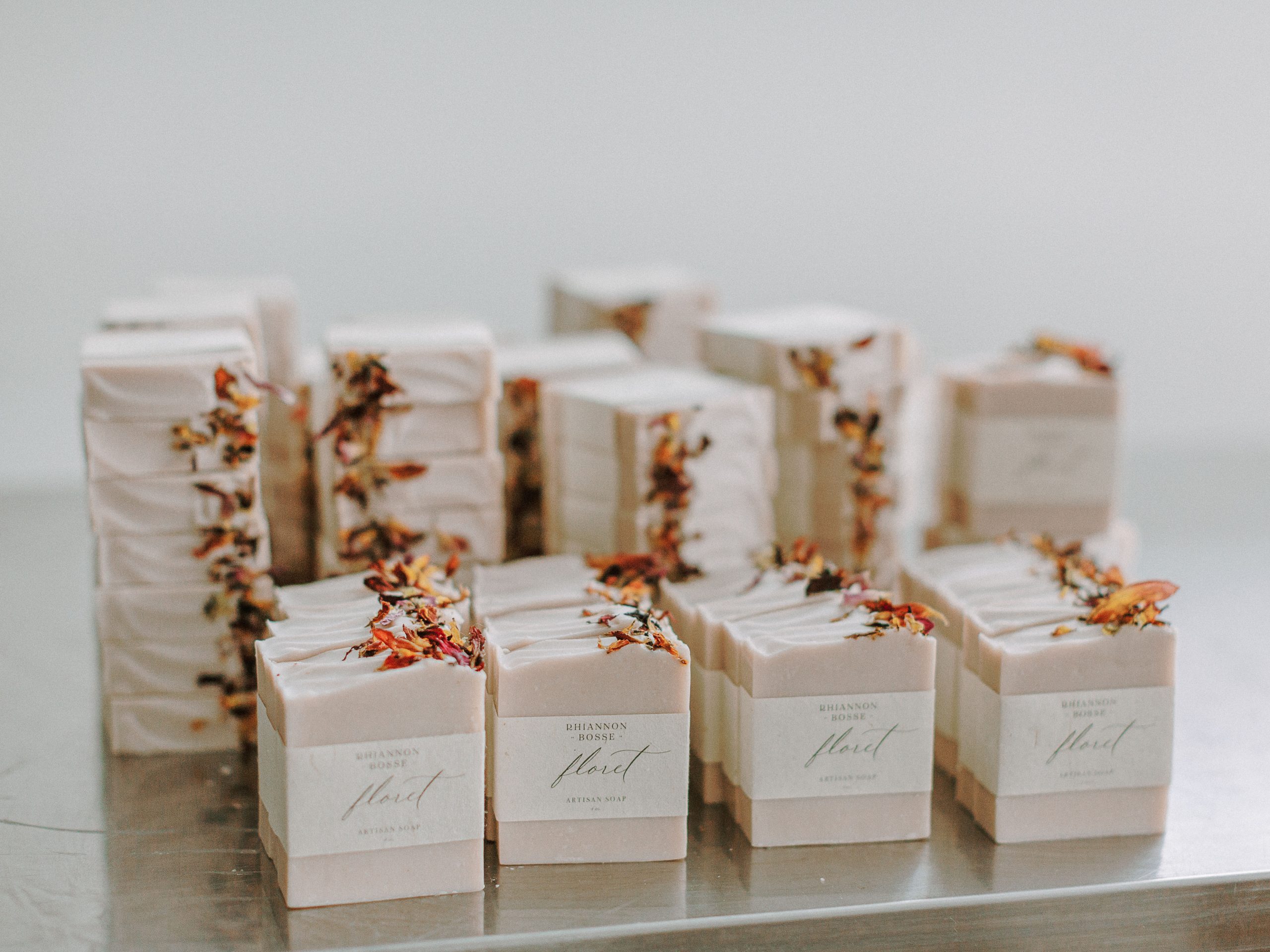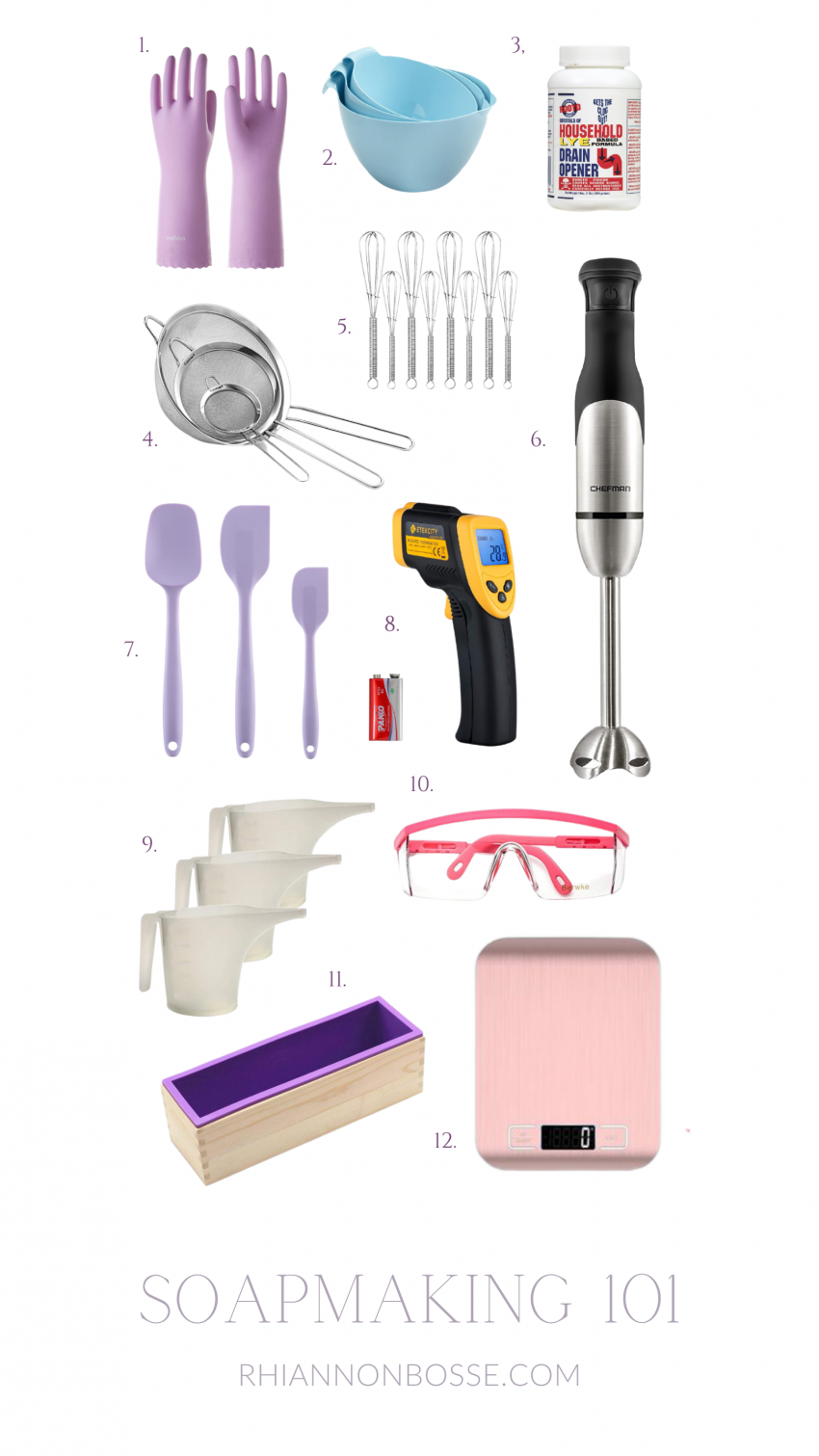

As promised, I wanted to follow up this post detailing the motivations behind opening a soapmaking business with one that includes my favorite soap making supplies! The list I’ve curated below is not an absolute collection or a rules book to follow, but instead a collection of things that I depend on and would likely need if I were going to make a standard batch of soap on any regular day. Consider this round up a list of your very basics to have a comfortable soaping experience! And I’m thrilled to share it with you.

Additionally, while tools and gear are important to make soap, just as important are your ingredients. Things like your oils, colorants, essential oils, botanicals, and so forth. While the tools to make soap are mostly universal, it’s the ingredients that go into the soap that are truly customizable. This is the part that beautifully blends together science and art, and is the part that I’m deeply drawn to.
To get started making soap, I would recommend a book on the topic or in the very least, some serious internet browsing to understand the basics. I first learned how to make soap from the incomparable Jan Berry via her blog The Nerdy Farm Wife. Her blog led me to purchase her soaping e-book, which led me to join her paid soaping Facebook group, which led me to gain the confidence to start my own soapmaking business. Through Jan’s teachings and online group, I gained endless support, community camaraderie, and troubleshooting help. If there was ever a soap making mentor to look up to it would be Jan, and as such, her newest book is also one I highly recommend. Like cooking, the recipes to make soap are vast and a lot of it comes down to personal preference.
Here are my soap making must-haves!

1. Safety Gloves Protecting your hands from wet soap batter is so important to help you avoid any caustic burns. And it’s very likely you’ll get soap on your hands in some capacity so just wear the gloves, folks! Many soap makers use disposable latex ones and sometimes those are easier to toss then cleaning flimsy throwaways but if you’re keen on reducing waste, reusable gloves are a great option. It’s also helpful to consider gloves that go up higher on your arm to prevent burns on the soft skin of your forearm.
2. Mixing Bowls You’ll need multiple bowls to mix your lye water, butters, and oils in. And it’s especially helpful to have something you can pour from, hold while you’re mixing, and easily fit into your sink for cleaning. I use paint buckets now, ones I’ve purchased brand new from the hardware store, but when you’re starting, a nested bowl set like this beautiful blue one is perfect. Make sure you don’t mix your soap batter in anything made of tin, aluminum, or copper and the same goes for your utensils you’re mixing with.
3. Lye Without lye you cannot make soap so it feels incredibly important to add to the 101 list. You can find lye at small hardware stores like Ace (they carry the same brand I’ve included above, which is my brand of choice), on many soapmaking supply websites, or even Amazon. Make sure you keep it out of reach from kiddos and far away from any curious pets, and before using be sure to read up on lye safety and feel prepared to handle it safely. Finally, your lye gets poured into your water, never the other way around!
4. Mesh Strainers I love my mesh strainer and use it often to strain my infused oils and sometimes, my infused lye solution. The is helpful to get clumps of botanicals or clay out of the batter as it’s tricky to find these clumps after pouring into your molds. Out of all the items on this list, this is probably the one that feels the most optional so feel free to skip over it if needed.
5. Mini Metal Whisks These little mini whisks are so helpful when I need to mix something in small amounts and a big whisk won’t fit or make sense. Typically I use them when make bi-colored soaps and there are multiple batches of batter to infuse color into. But I also use them when I make my dish soap pucks and need to mix citric acid together with lime juice. They are inexpensive and nice to have!
6. Immersion Blender Can you believe before hand mixers were invented people had to HAND MIX their soap to trace? Trace is a fancy soaping term which relates to the thickness of the soap with a thicker trace resulting in a thicker, easier to pour batter. An immersion blender helps cut down hours of stirring time to sometimes just minutes and in my opinion, is one of the most necessary soapmaking tools! Make sure your soaping immersion blender is not the same as the one you use in your kitchen.
7. Spatula Set These purple spatulas are such a beautiful color and will come in handy at multiple parts of the soapmaking process. Whether your mixing heated up oils and butter together, stirring lye into your distilled water, scraping your soaping bowls to ensure every last bit of soap batter is salvaged, or making swoop patterns in the top of your soap loaf, you’ll use your spatulas often.
8. Digital Thermometer Once you’ve learned the basics of soapmaking and how critical temperature is to the process, you’ll want to invest in a handy digital thermometer to help you in your soap making endeavors. I’m at a point in my soapmaking journey where I don’t really depend on my thermometer to mark when my lye water and oils are ready to use, but there are certain cases where this comes in handy and this was especially true when I first started soaping and wanted to be meticulous with my approach.
9. Easy Pour Containers This seems like the ultimate utilitarian item on the list, but my easy pour containers are a great help in making my soap pouring process more accurate. I only own two and am always wishing I had a few others on hand in the middle of making a batch. Use these to pour batter into smaller, intricate molds or when making soap with swirls or multiple colors.
10. Protective Eyewear I’ve read a few horror stories in my soaping groups where people have gotten a splash of lye water or soap batter into their eye and they are left a burn – on their eyeball! Yikes. Invest in a nice pair of protective eye wear and be safe instead of sorry. Bonus points if the pair you invest in is more of a google-style and eliminates any space where flying batter could sneak in and land on the delicate skin around your eyes (been there, ouch). Also, you need a suitable face mask / respirator for your lye mixing efforts, and any other project where fumes and dust can get in your lungs. Here’s a great article on where to start.
11. Soap Molds This is an another important, if not obvious, soapmaking ‘tool’. A soap mold is something you pour your soap batter in and the mold options are really endless (think: shapes, small molds, tray molds, homemade molds, tube molds, and the list goes one). These purple silicone molds are pretty popular in soaping land, easy to source, and affordable. I actually have eight of them myself – so I can make up to two batches of soap on the same day – and they have held up well for years now.
12. Digital Scale Equally as important as tools like your immersion blender and protective gear, you’ll want to invest in a quality digital scale, and preferably one that shows you two numbers to the right of the decimal. Weighing out your ingredients as accurately as possible ensures the best final product, and perhaps, more importantly, usable soap. You’ll also want something with a wide enough base for your bowls along with a capacity for higher weights as your soaping limit increases with comfort. This dusty rose scale is so beautiful and would be perfect for beginner soap makers working in small batches!
. . . . .
If you make your own soap, which tools are most essential for you? Or if you’re simply intrigued by the soap making process, is there an essential on this list that surprises you? I’d love to hear from you below and get great joy out of conversation with my readers! Xo
Photography by Samantha James Photography
Affiliate links are used in this post!